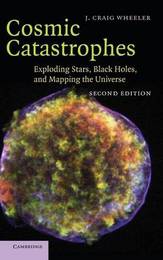
|
Cosmic Catastrophes: Exploding Stars, Black Holes, and Mapping the Universe
Hardback
Main Details
| Title |
Cosmic Catastrophes: Exploding Stars, Black Holes, and Mapping the Universe
|
| Authors and Contributors |
By (author) J. Craig Wheeler
|
| Physical Properties |
| Format:Hardback | | Pages:358 | | Dimensions(mm): Height 229,Width 152 |
|
| Category/Genre | Galaxies and stars |
|---|
| ISBN/Barcode |
9780521857147
|
| Classifications | Dewey:523.84465 |
|---|
| Audience | | Tertiary Education (US: College) | |
|---|
| Edition |
2nd Revised edition
|
| Illustrations |
Worked examples or Exercises
|
|
Publishing Details |
| Publisher |
Cambridge University Press
|
| Imprint |
Cambridge University Press
|
| Publication Date |
4 January 2007 |
| Publication Country |
United Kingdom
|
Description
From supernovae and gamma-ray bursts to the accelerating Universe, this is an exploration of the intellectual threads that lead to some of the most exciting ideas in modern astrophysics and cosmology. This fully updated second edition incorporates new material on binary stars, black holes, gamma-ray bursts, worm-holes, quantum gravity and string theory. It covers the origins of stars and their evolution, the mechanisms responsible for supernovae, and their progeny, neutron stars and black holes. It examines the theoretical ideas behind black holes and their manifestation in observational astronomy and presents neutron stars in all their variety known today. This book also covers the physics of the twentieth century, discussing quantum theory and Einstein's gravity, how these two theories collide, and the prospects for their reconciliation in the twenty-first century. This will be essential reading for undergraduate students in astronomy and astrophysics, and an excellent, accessible introduction for a wider audience.
Author Biography
J. Craig Wheeler is Samuel T. and Fern Yanagisawa Regents Professor of Astronomy and Distinguished Teaching Professor in the Department of Astronomy at the University of Texas Austin. He was elected President of the American Astronomical Society in 2006.
Reviews'Wheeler's is one of those rare popular science books that leaves readers both thoroughly entertained and considerably more expert than when they began. Written in a lively, jargon-free style, laced with personal anecdotes, this is a hard-to-put-down, deeply satisfying book.' Kitty Ferguson, author of the best-seller, Stephen Hawking: Quest for a Theory of Everything 'The writing style is very informal and the explanations are kept at a general, nonmathematical level ... very informative and well worth reading. It is as up to date as possible on some of the most exciting and cutting-edge topics in astrophysics ... I would feel comfortable using this book as a text in a survey-level astronomy class, and I would also happily recommend it both to amateurs interested in following current topics in astrophysics and to my physicist colleagues.' Sky & Telescope '... the explanations in the book are exceptionally clear and accurate ... Many of the topics discussed by Wheeler, such as gamma ray bursts, and the connections between quantum gravity and cosmology, are at the forefront of research ... Wheeler communicates the excitement of astrophysics, while highlighting what is understood but also bringing his readers to the brink of the unknown.' American Journal of Physics '... a scholarly yet readable account of violet events in the Universe ... The author ... is one of the world's leading experts in these fields and he writes with immense authority. ... I have no doubt that it will run to many editions ...' BBC Sky at Night Magazine '[This] second edition [is] intended for use in classes for non-scientists. ... the book is exceedingly well written...' The Observatory 'This is a splendid book, written in a direct and exciting style and addressing head-on the difficulties which recent research has placed on time-honoured views and on evolving theories of Cosmology and Stellar Astrophysics ... Wheeler is quick to address not only the successes of recent decades but also the difficulties to which those successes lead within the tapestry of the physics of the last century ... to conclude his journey through this rapidly development world of astrophysics Wheeler examines the seemingly magical possibilities inside the event horizon, the world of worm hole time machines and quantum foam.' F.A.S.Newsletter
|